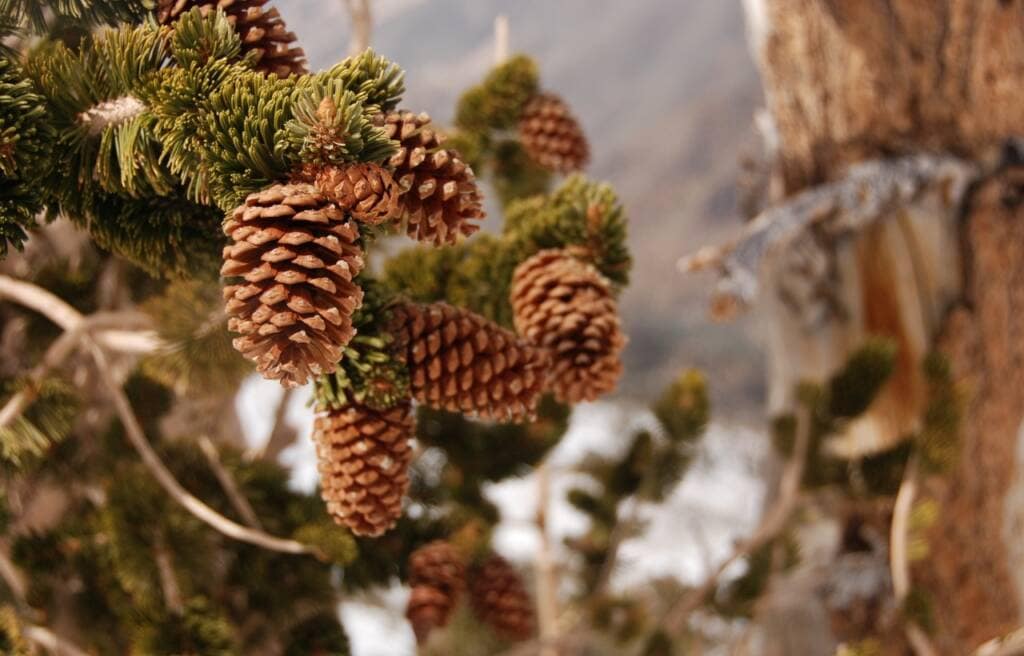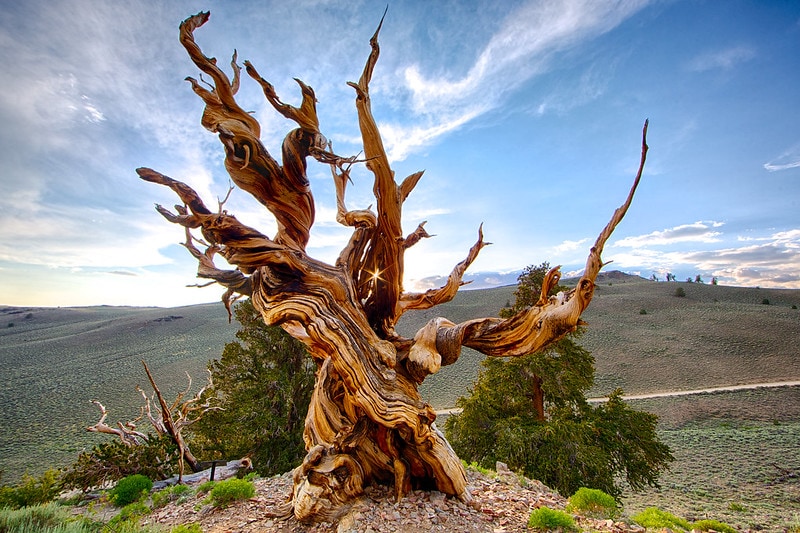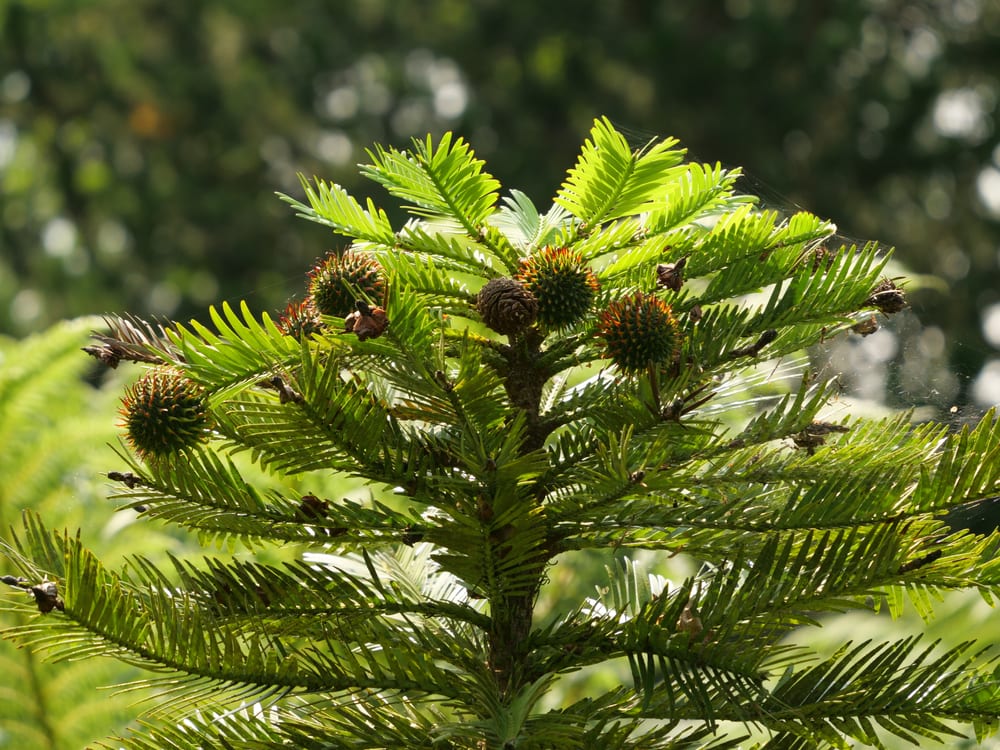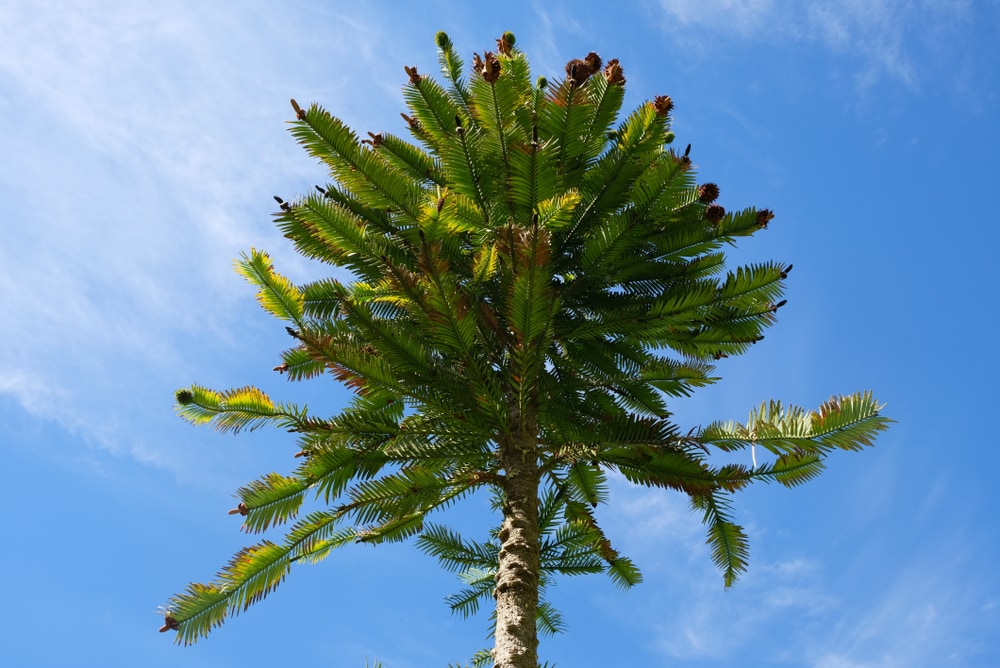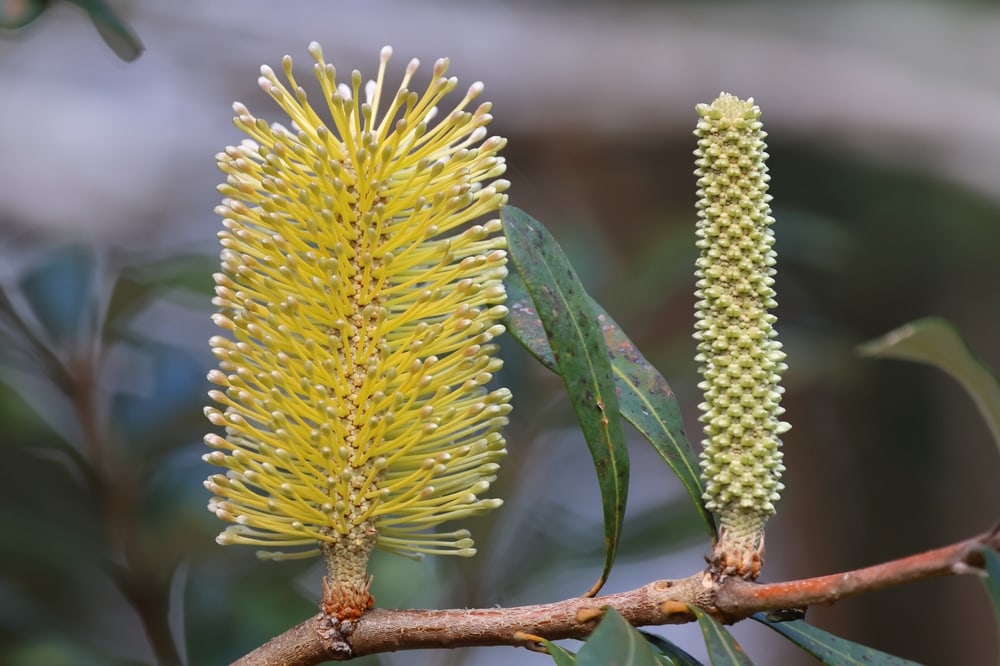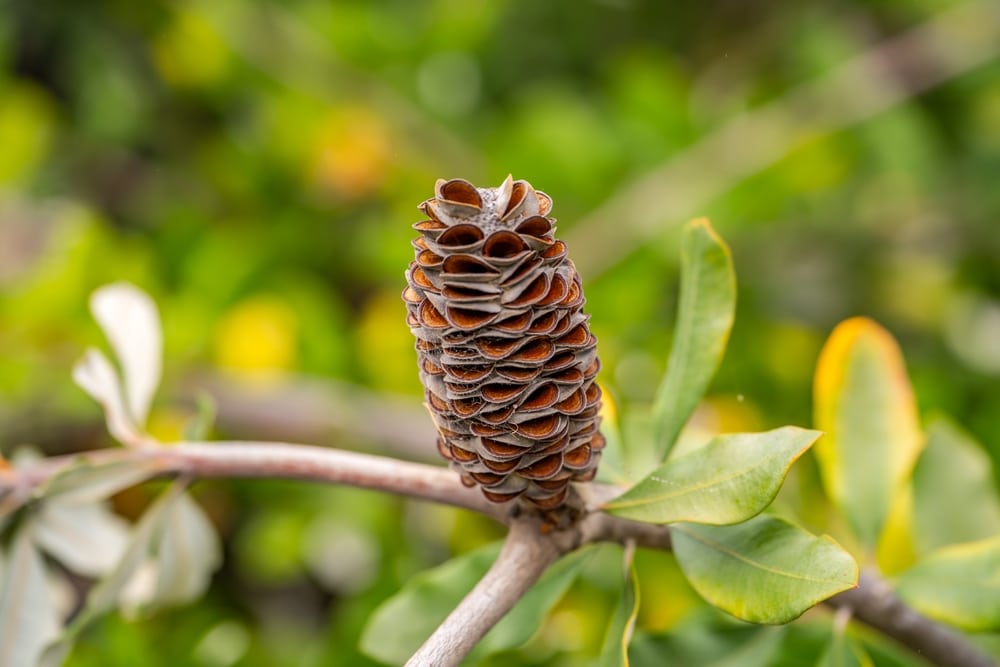Outforia Summary: Key Takeaways
- Pine cones are produced by Gymnosperm trees and are the reproductive parts of a pine tree, protecting the seeds until they mature.
- There are over 120 different types of pine trees worldwide, each with unique cone sizes, shapes, and scents.
- While there are many fascinating ones, some examples of unique pine cone types include Monterey Pine Cones, which are unlocked by fire; Coulter Pine Cones, the largest and heaviest; and Eastern Hemlock, the tiniest pine cone.
- Pine cones have various adaptations for seed dispersal, such as opening by fire or releasing seeds through wind or animal interaction. They serve to safeguard seeds until maturity and help disperse them far from competing parent trees.
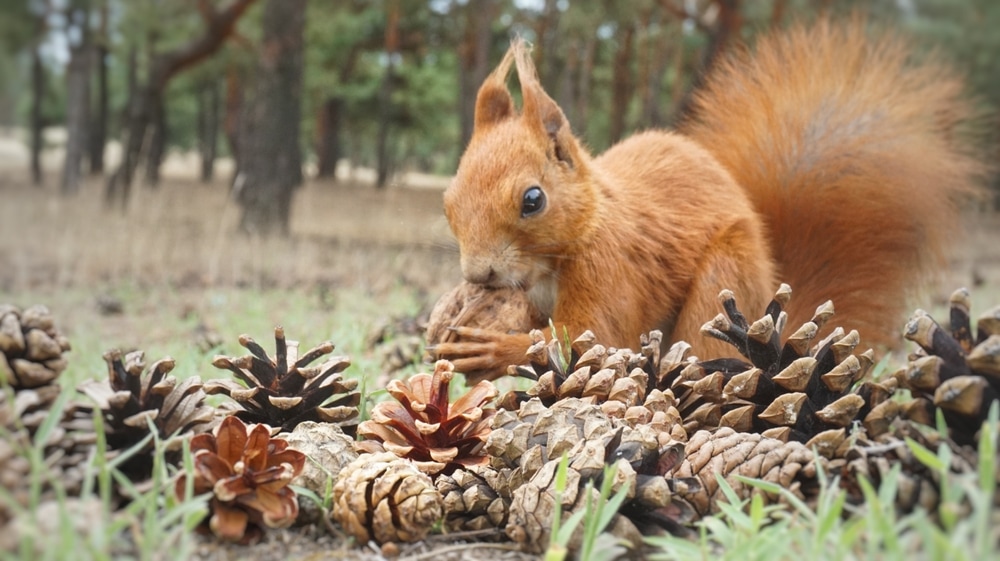
Pine cones are produced by trees from the family of Gymnosperm trees. This is an ancient type of tree that reproduces with exposed seeds (like cones) instead of fruits.
Many of the Gymnosperms use the wind to carry their pollen. Reproducing using the wind means these trees aren’t reliant on water for reproduction.
There are over 120 different types of pine tree worldwide. Every one of those has cones of a different size, scent, and shape!
Why Do Trees Have Pine Cones?
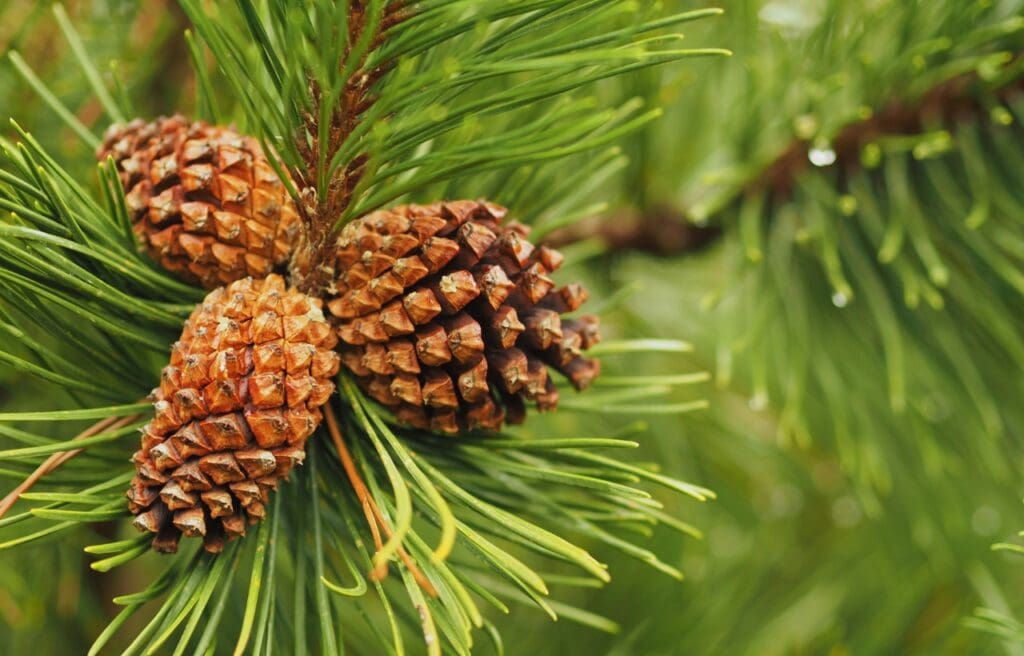
Pine cones are the reproductive parts of a pine tree. Some cones are male and release pollen to fertilize female cones. The female cones then produce seeds.
Pine trees have cones to protect their seeds until they are mature. As Gymnosperm trees, their name means ‘naked seeds’ in Greek. All this means is that they aren’t covered by a fruit. However, they’re still well protected by their tough cone scales.
Sometimes, the pine cone helps the mature seed disperse far enough away from the parent tree. The seeds need to get far enough away to not be in competition with their parents for sunlight and nutrients.
Now, with that all cleared up, let’s check out the different types of pine cones!
The 20 Different Types of Pine Cones
1. Monterey Pine Cones (Pinus radiata) – Unlocked by Fire!
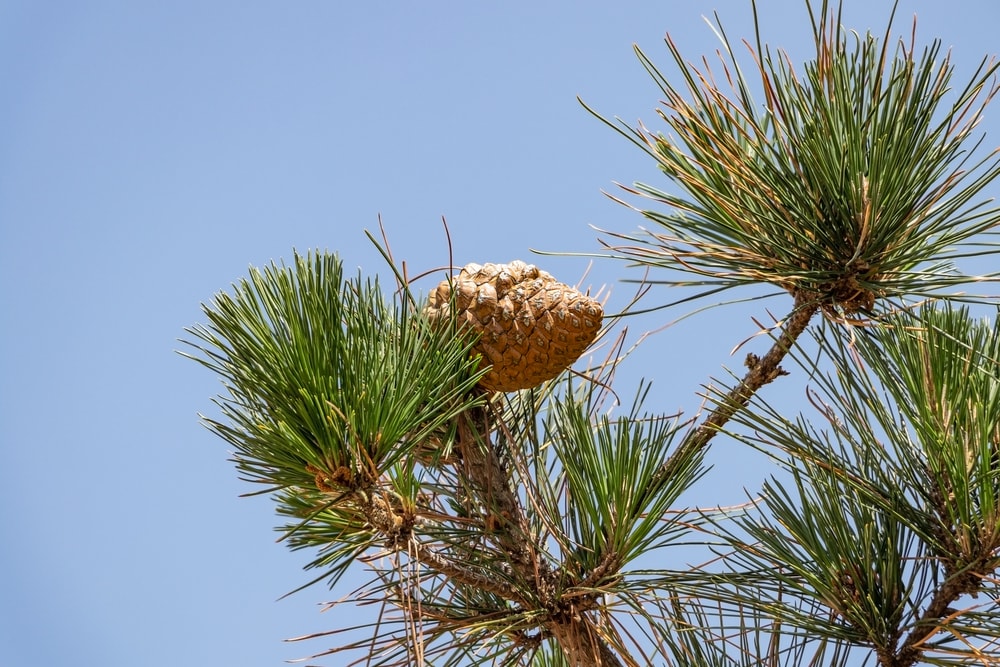
The Monterey Pine is native to California. It only grows naturally in 5 different places – though it has been planted around the world.
The cones have evolved to pop open once heated by California’s frequent wildfires! This means the seeds have the best chance of survival as the surrounding plants have been burned away.
Each one of these big cones can produce up to 200 seeds. I’ve also eaten these. However, the seeds within are small and quite fiddly to collect!
2. Coulter Pine Cones (Pinus coulteri) – The Largest & Heaviest Pine Cone
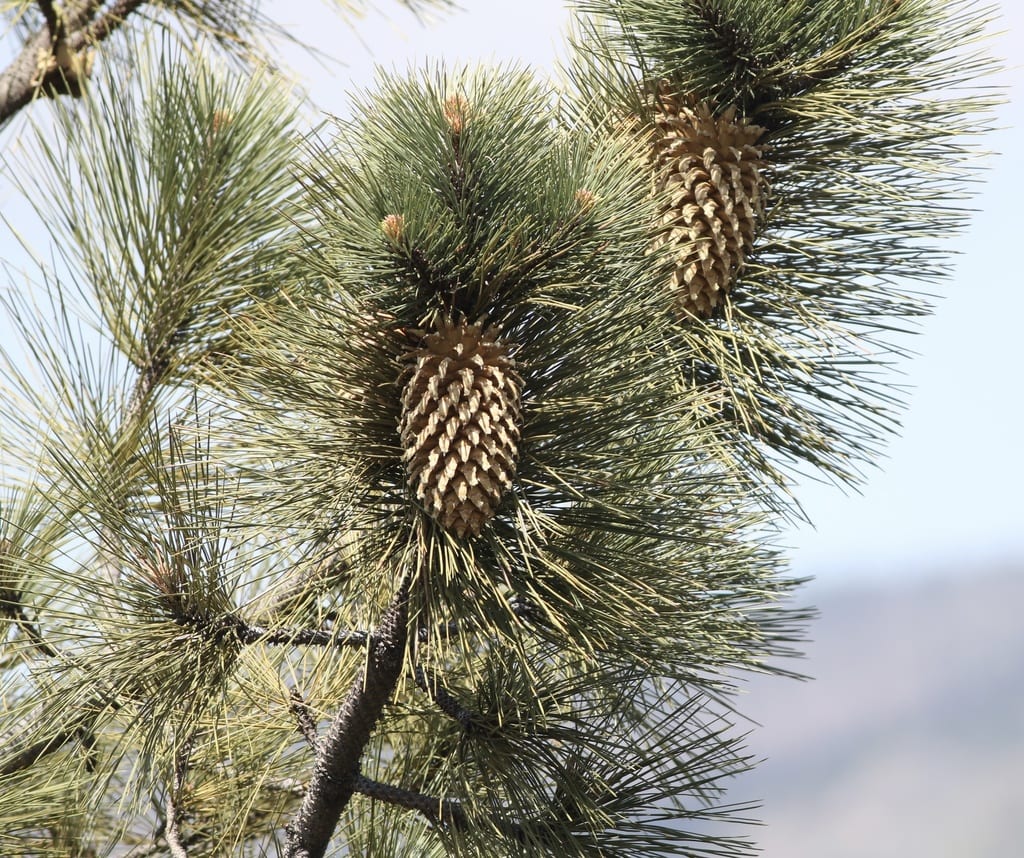
The heaviest pine cones come from the Coulter Pine (Pinus coulteri). This pine tree lives in California and Mexico.
Coulter pine cones can weigh 5kg (11lb). They are known as ‘widowmakers’ as if one lands on your head, your wife (or husband) will be a widow!
3. Eastern Hemlock (Tsuga canadensis) – The Tiny Pine Cone
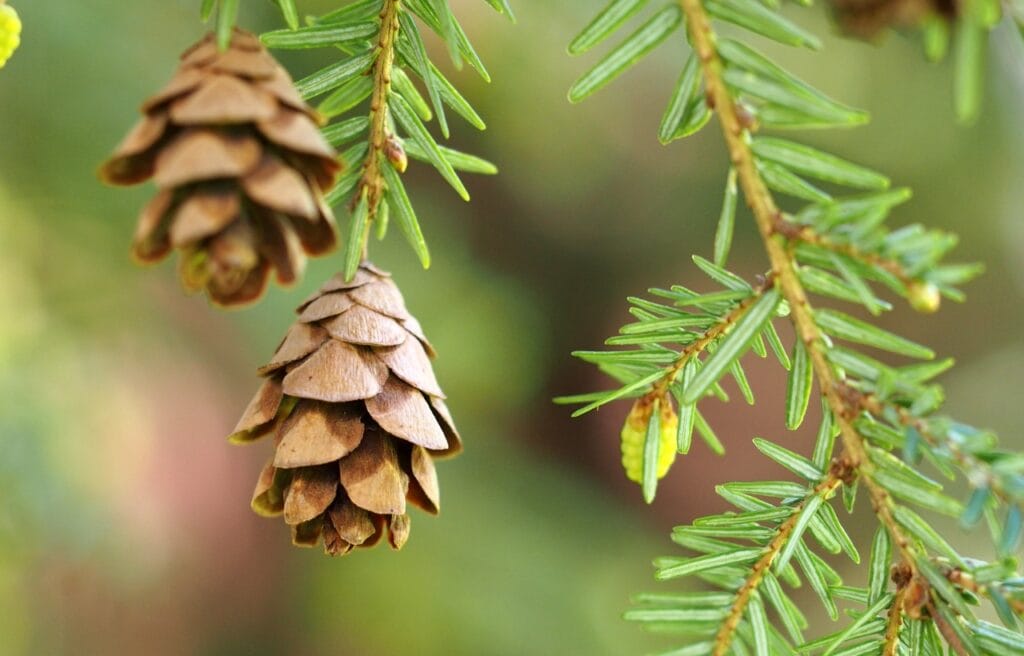
The Eastern or Canadian Hemlock Pine has tiny cones only ¾ of an inch or 1.9 cm long.
They start off light green then change to brown as they mature. They have a smell similar to the poisonous plant Hemlock, hence the name. However, this tree is not related to Poison Hemlock.
4. Jack Pine (Pinus banksiana) – Curviest Pine Cone
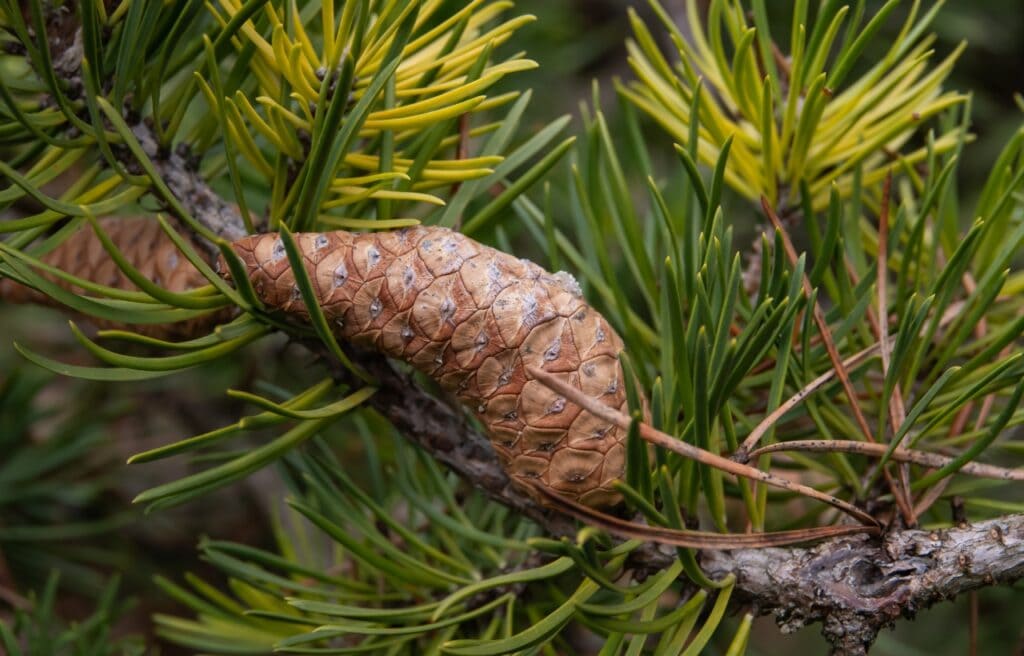
Jack Pine cones are bent like a banana! They have an irregular shape and close fitting scales with a purplish bump in the middle of each.
They adapted to be opened by fire, like the Monterey Pine. They also stay on the tree for several years.
The Jack Pine is a tough tree that will grow where nothing else will. The trunk is often crooked and the appearance of the tree is scraggly.
5. Bristlecone Pine Cone (Pinus longaeva) – Oldest Pine Cone
The Bristlecone Pine tree has the longest lifespan of any individual species of animal or plant. A tree has been found in the US that has lived more than 5,000 years! That’s older than the Pyramids!
The tree is called Methuselah and it lives in the Inyo National Park on the border between Nevada and California.
Ok, so the pine cones the tree produces are not this old! However, they are carrying on this proud lineage. The female pine cones have bristles on them, which is why this tree is called the Bristlecone Pine.
6. Sugar Pine Cone (Pinus lambertiana) – Sweetest & Longest Pine Cone
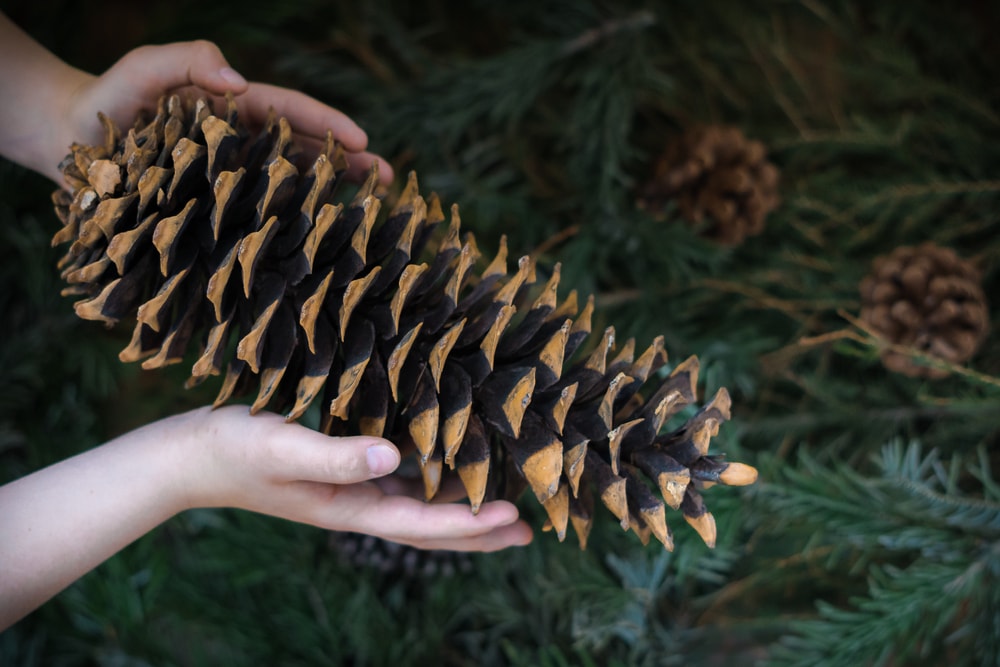
This pine cone wins two titles!
The Sugar Pine produces the longest cones. They can reach a whopping 50 cm (20 in) long. That’s as long as an adult human’s arm! All of them grow to 25 cm (9.8 in) or more.
Sugar pine cones are also the sweetest cones. They produce a sugary sap which crystallizes all over the cone. This was eaten as a sweet by Native Americans. It has a slight laxative effect when eaten raw. Due to this, it’s cooked before eaten.
I’ve had great fun getting this sap off my and my son’s fingers. Although messy, it’s completely harmless. The only way to get it off is to use margarine, vegetable oil or clarified butter!
7. Siberian Pine (Pinus sibirica) – Most Competitive Commercial Seed
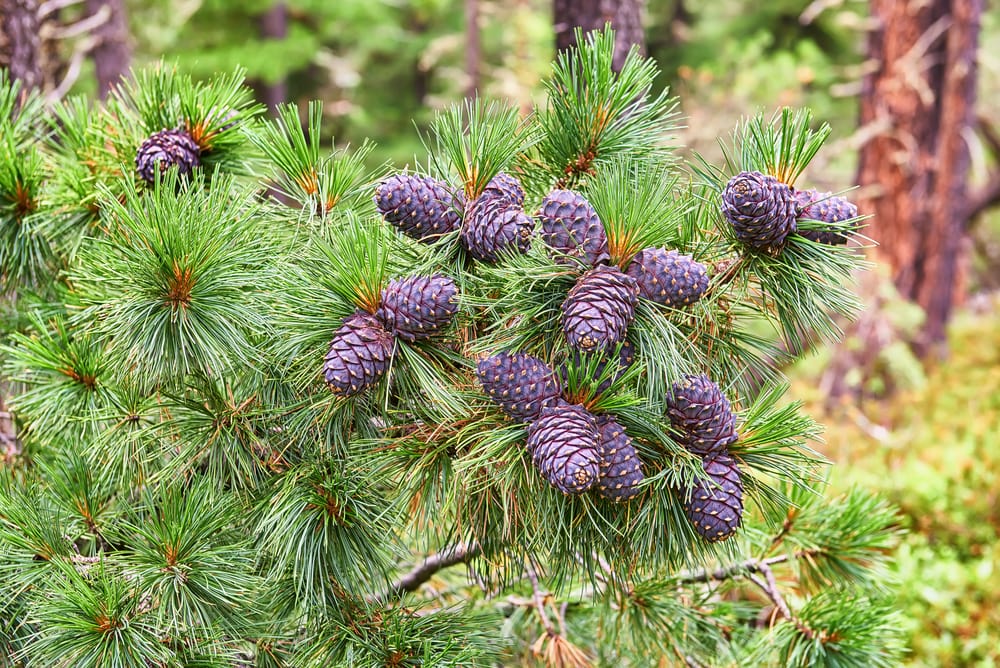
Siberian pine cones hold an important crop. These pine seeds are fast catching up with Italian Stone Pine as the kind of pine seed most often sold as food worldwide. The cones are also a cool purple color!
Instead of using the wind, most of these seeds are spread in the wild by Spotted Nutcracker birds. The seeds also have a tiny vestigial wing on them.
In Russia, the seeds are sold as ‘Cedar Nuts’. It’s also resistant to rust fungus and can tolerate cold temperatures down to minus 60C!
8. Lodgepole Pine (Pinus contorta) – A Spiny Pine Cone with Twisty Needles
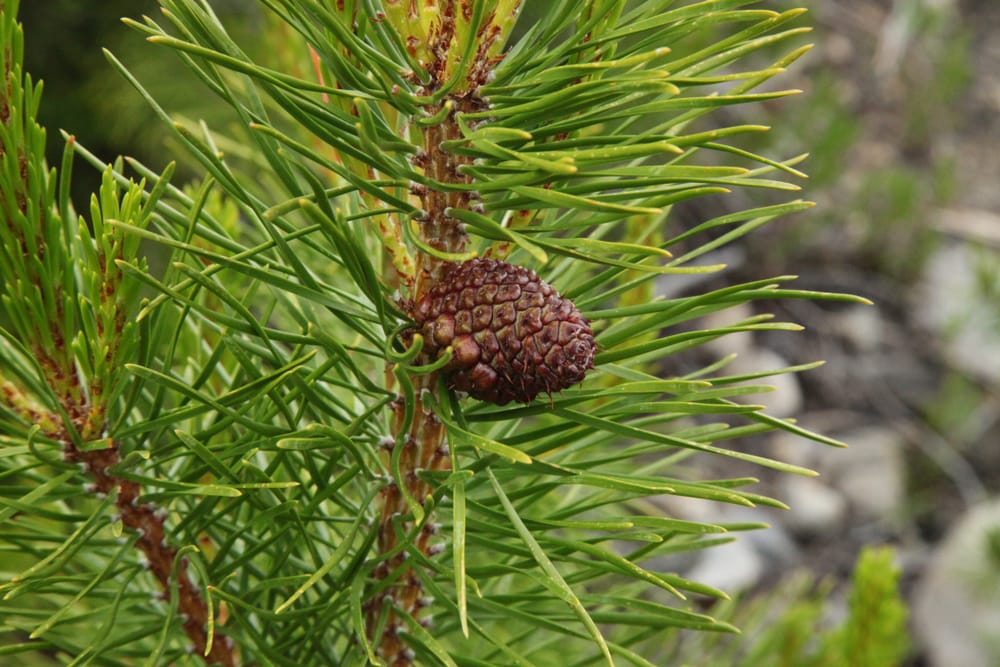
The prize for the spiniest pine cone must go to the Lodgepole Pine. Each scale on its cones bears a fang-like spike. However, the extent of this depends on the type of Lodgepole Pine. There are several types of Lodgepole Pines with round or spear shaped cones.
Lodgepole Pines all have needles that are twisted as they grow.
These are another pine that, like the Monterey Pine, enjoys the kiss of fire! The cones are sealed with resin. These cones need extreme heat to crack the seal and release the seeds.
9. White Pine Cone (Pinus strobus) – The Official State Flower That’s Not A Flower
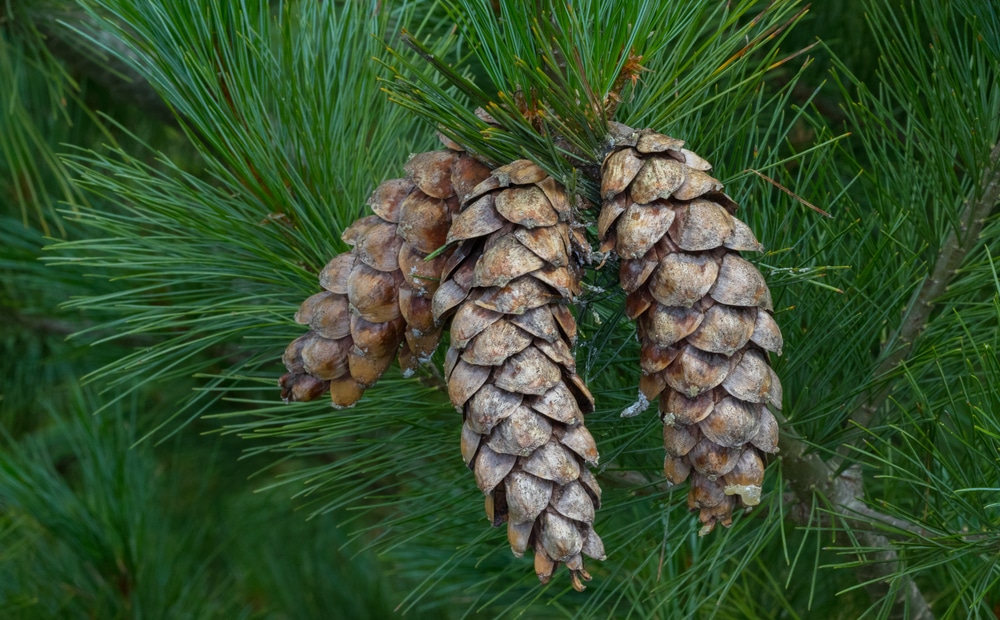
In Maine, the official state flower chosen to represent Maine is the White Pine cone. This is unusual, as the pine cone is not a flower. In fact, it remains the only state flower to not actually be a flower!
The White Pine is considered to be the largest conifer in the area of Maine and northeastern US. It has thick tufts of long bluish green needles in bundles of five.
The pine cone has a slight curve and is 4-5 inches (10 to 12 cm) long with a lovely scent. Its scales are smooth without prickles, too.
This tree covers the state of Maine. It was even used in shipbuilding due to its long, straight trunks.
10. Stone Pine Cone (Pinus pinea) – The Sun Lover
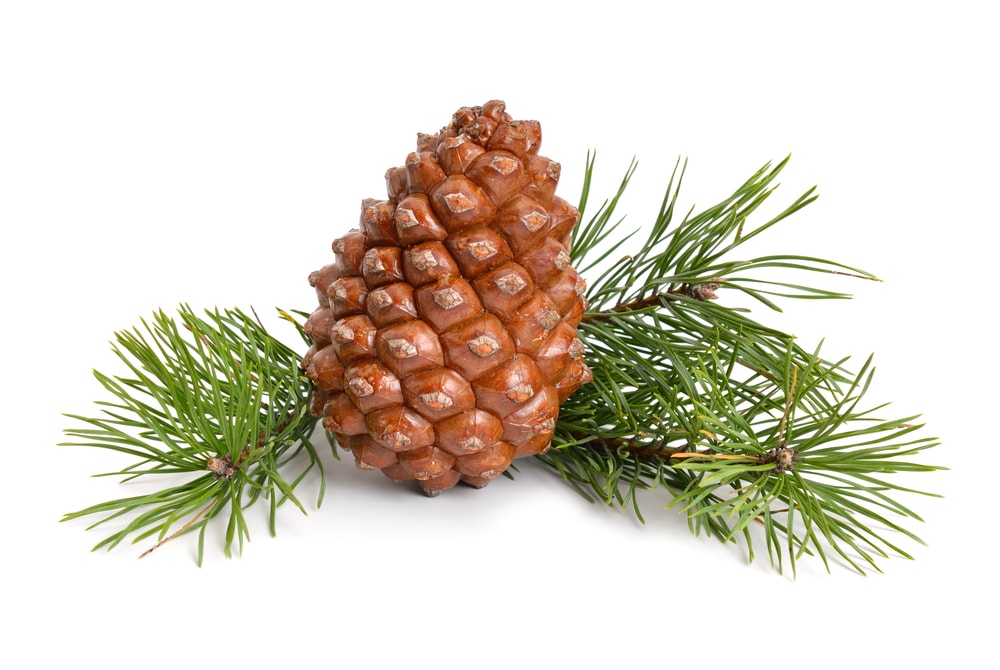
The beautiful Stone Pine, also known as the Umbrella Pine, is native to the Mediterranean regions. It grows elsewhere, but unlike many other pines will only tolerate low temperatures down to about -10 C. This means it prefers to live in temperate and warm climates.
The cones are as big as a hand and weigh from 250-350 grams (8.82 – 12.3 oz).
Stone Pine is famous for its large, delicious seeds. These are the seeds you usually buy as Pine Nuts in the supermarket. They are often sprinkled on pesto.
Stone Pines love to grow in sandy soil, which is why they’re used as a windbreak on sand dunes. Their resin is also used to make rosin, a substance rubbed on violin bow strings!
11. Japanese White Pine Cone (Pinus parviflora) – Best For Bonsai
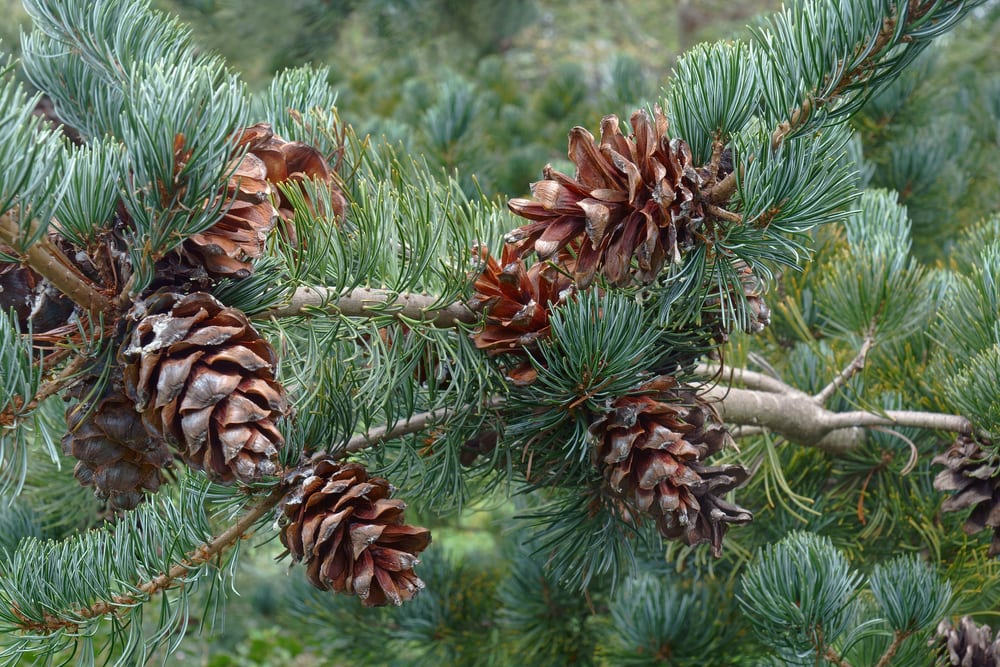
Japanese White Pine is the tree most favored by Japanese bonsai growers for creating miniature pine trees. Bonsai is the art of controlling a tree’s growth to make a tiny specimen that can be grown in a tray.
Japanese White Pine female cones are small, measuring 6-8 cm (2.4 – 3.1 in) long. They grow in clusters of up to 10 near the end of the branches. Its male cones grow in even bigger clusters of about 30 further up the branch.
Japanese White Pine has five needles per fascicle, which is the papery sheath the needles grow out of.
12. Wollemi “Pine” Cone (Wollemia nobilis) – An Australian Pine That’s Not a Pine
Despite this tree being called a pine since its discovery, it’s technically closer to the Araucaria family of plants, which includes the Monkey Puzzle Tree. However, these trees are still part of the cone bearing Gymnosperms.
The Wollemi Pine is the rarest tree in the world, with only 100 specimens alive in the wild in Australia. This makes its cones pretty rare, too.
This species even dates back to the time of the dinosaurs. A 90 million year old Wollemi Pine fossil shows that this plant was around in the Jurassic period!
The Wollemi Pine can protect its new buds with a white waxy coating, which helped it survive dormant through many Ice Age winters. In terms of appearance, the cones are small and appear right at the tips of the feathery branches.
13. Maritime Pine Cone (Pinus pinaster) – A Cone That Pines for the Coast
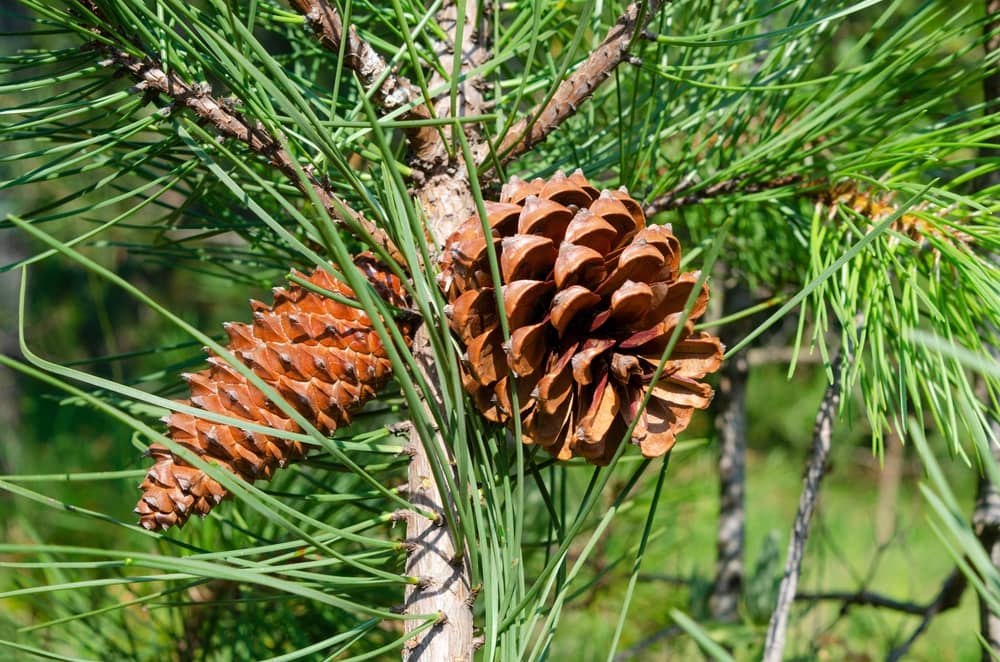
The Maritime pine loves the coast! This tough pine enjoys sandy soil and covers about 10% of France’s wooded areas. It also loves the European and Mediterranean coastline.
This pine is known as the Golden Tree due to its strength, resilience, and light green needles. It can handle drought, storms, and salt spray. However, it’s less keen on frost!
The female cones take three years to reach maturity, which is why they remain on the tree for a long time! As they mature, the cones slowly turn a shiny reddish brown.
On the other hand, the male cones produce so much pollen that it’s known as sulfur rain!
14. Mexican Weeping Pine Cone (Pinus patula) – The Pine Cone with Droopy Needles
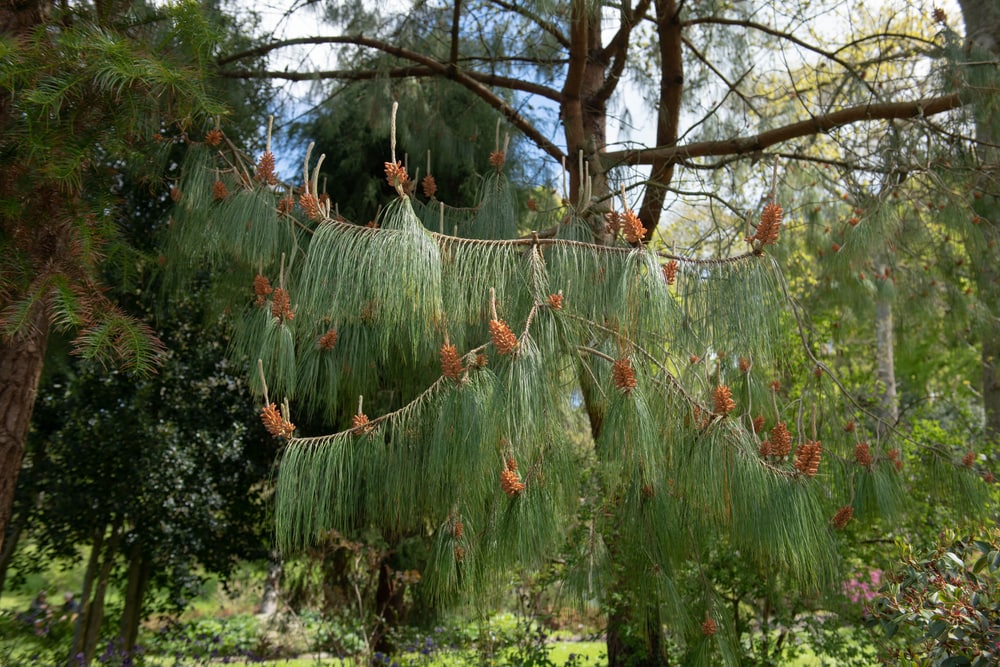
This South American pine has unusually long drooping needles. Hence the name “weeping pine”. It’s also known as the “Patula pine” or “Jellicote pine”. In Spanish, it’s known as “pino triste” – the sad pine!
The female cones are bunched up at the end of the branches, with naked tips that protrude upright. The male cones are pinkish-yellow when immature. They go brown once they mature and release their pollen.
This tree bears important wood used for lumber in Mexico, as its trunk is very straight.
15. Mugo Pine Cone (Pinus mugo) – The Pine Cone That Grows Low
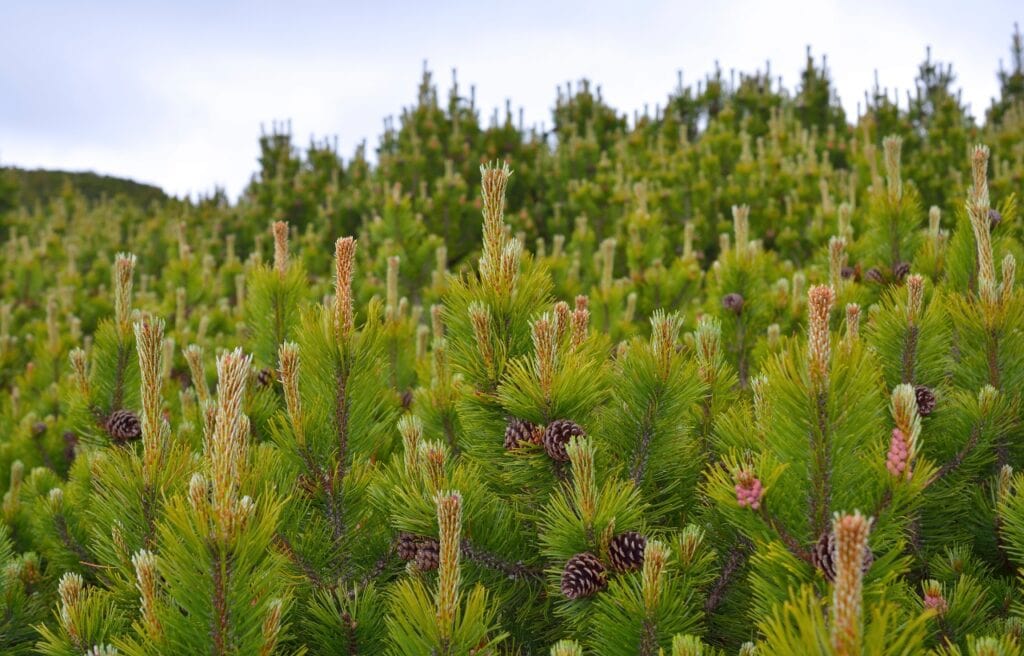
These cones come from the dwarf Mugo pine and grows more like a shrub.
This tiny pine is grown in rockeries as a decorative plant. It only reaches 3-6 feet (0.9-1.8 m) in its dwarf version. Even as a small tree (the bigger version), it won’t get taller than 10-25 feet (3-7.6 m).
This mountain plant is native to European mountain ranges such as the Pyrenees and Carpathians. Low growing plants with thick needles stay out of the chilling winds, which is why it’s so small.
The male cones stick up like candles and are a lovely golden yellow. The female cones are dry, brown, and 1-2 inches (2.5 to 5 cm) long.
16. Pinyon Pine Cone (Pinus edulis) – The Tastiest Pine Cone
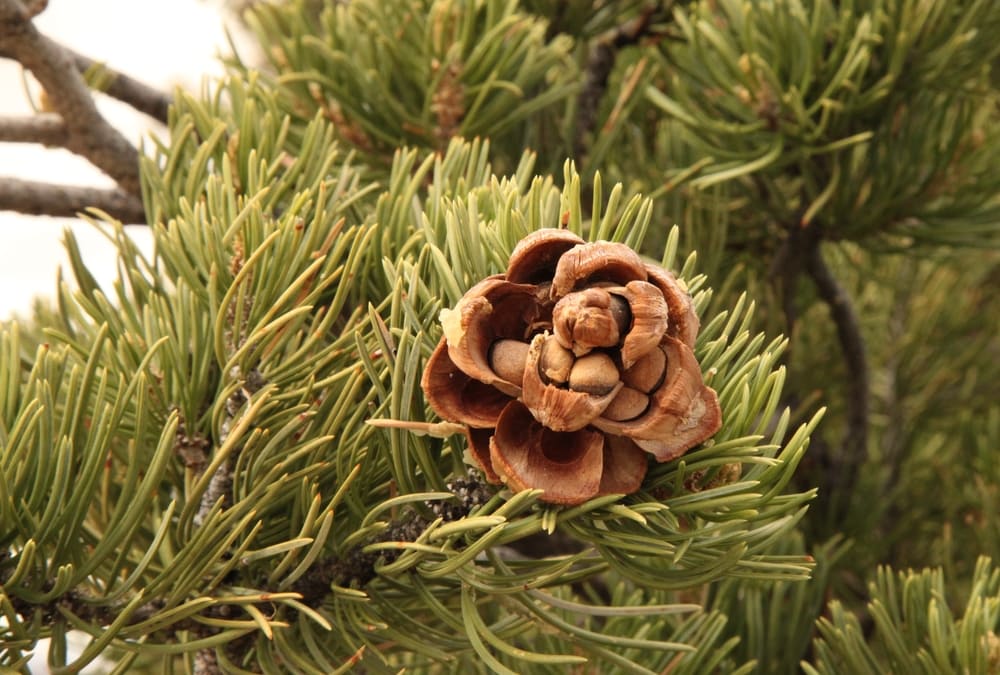
The Pinyon Pine cones hold tasty seeds or nuts that grow in the Western and Central US and Mexico.
Its seeds are used to make cakes, cookies, and even candles! They’re a valuable commercial crop, second only to pecans in value to the US. Native Americans also used them raw and cooked.
The whole tree has an aromatic fragrance, making it popular as a Christmas tree. You can even make incense from crushed Pinyon Pine cones.
The Native Americans use pitch glue made from Pinyon Pine to waterproof baskets and glue jewelry. Its wood isn’t much use for timber, though.
17. Pitch Pine Cones (Pinus rigida) – The Sticky Pine Cone
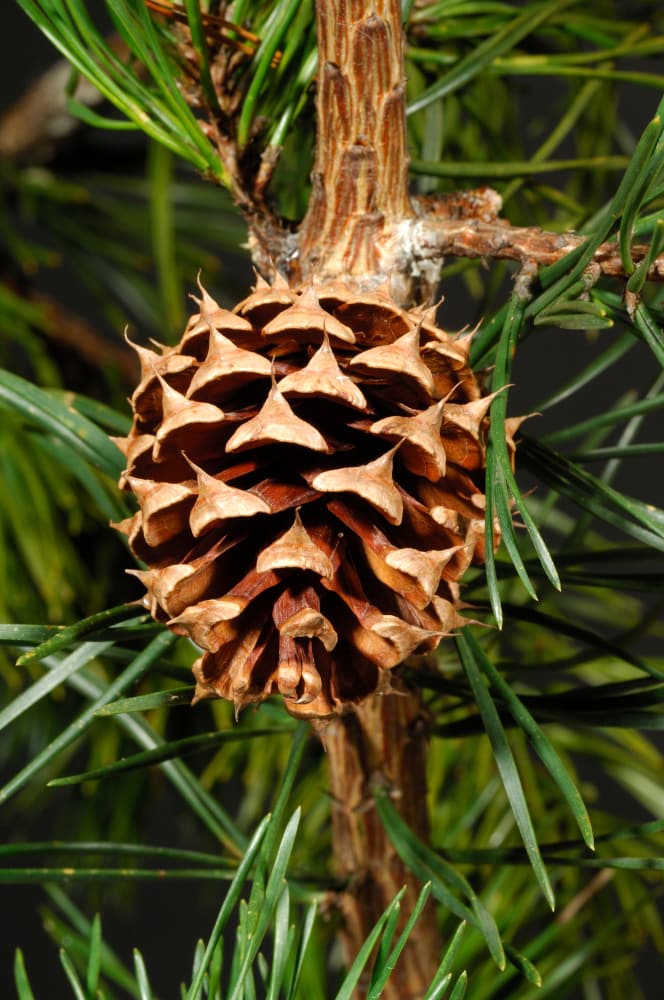
The Pitch Pine is a North American tree. This pine is very useful as a building material due to the high level of pitch in the wood. It also doesn’t rot for a long time, which is why it was used to make radio towers, ships, and railroads.
Pine pitch is useful for making glue and turpentine. It was also used as wound dressings as it repels fungi and bacteria. Native American Iroquois people used it in wound care and healing salves, as well as making canoes.
Pine pitch can be extracted from the tree and processed a number of different ways. Here’s one below that uses a Swedish tjärdal – a “tar ditch kiln”.
The female cones are medium-sized and brown.
You can check out this amazing tutorial on how you can make a pine tar from scratch using simple tools:
18. Ponderosa Pine (Pinus ponderosa C. Lawson & Lawson) – The Poisonous Pine Cone
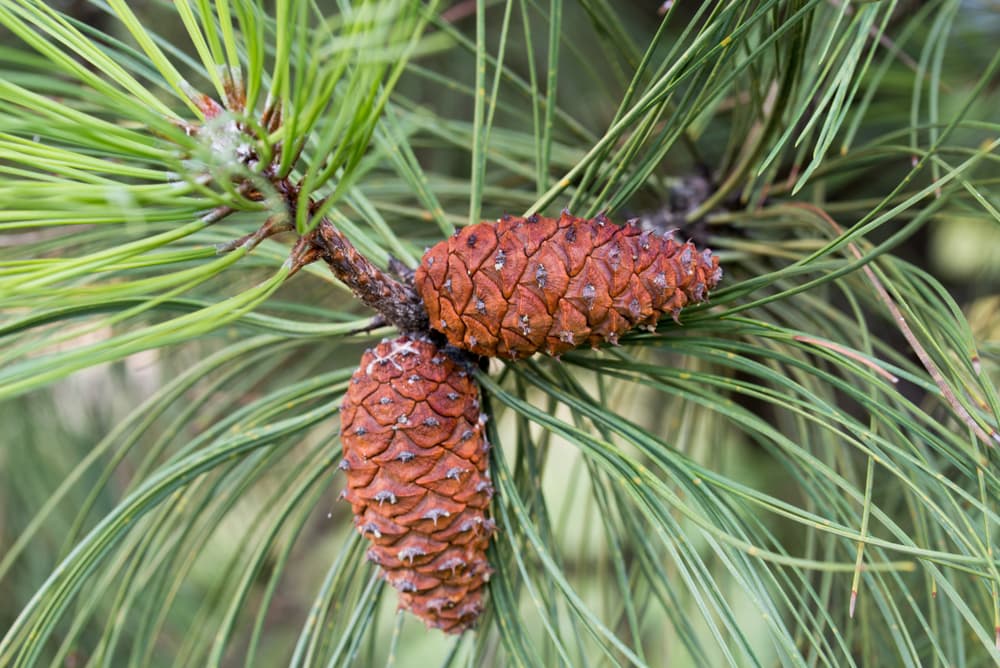
Ponderosa Pine is a poisonous pine tree. It contains isocupressic acid in its needles and outer bark, which causes abortion in livestock. It also causes renal failure and paralysis. This same chemical is also found in common juniper!
However, native Americans have long histories of eating the seeds from Ponderosa Pine cones without ill effects! They even used the pine’s heated needles to help deliver the placenta from a woman that had just given birth.
The cambium layer was also eaten by Native Americans. This is the thin layer of living tissue that the tree uses to transport nutrients under its bark.
19. Torrey Pine Cone (Pinus torreyana) – The Rarest Pine Cone in the US
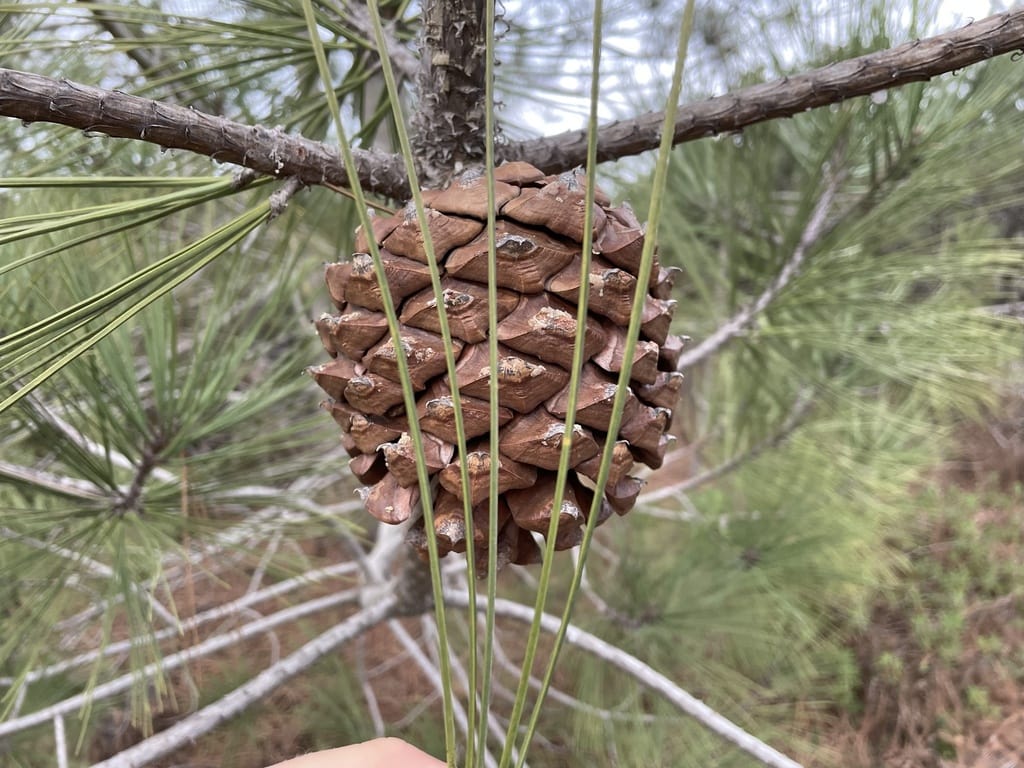
The Torrey Pine is a critically endangered tree outside of the US.
The tasty nuts, which are very hard on the outside, need a nutcracker to open them. They’re said to be delicious and larger than most other pine nuts except one type of Pinyon Pine.
Torrey Pine cones stay on the tree for up to 10 years. They usually fall out by the third year. Some of the seeds will even stay on the tree for that long until the cone falls.
The seeds only have a small wing and tend to fall straight down. They’re usually collected by a jay and buried as food for the winter. The new young tree then grows out of a jay’s forgotten stash.
20. Dalat White Pine Cone (Pinus dalatensis) & Maxipiñon Pine Cone (Pinus maximartinezii) – The Rarest Pine Cones in the World
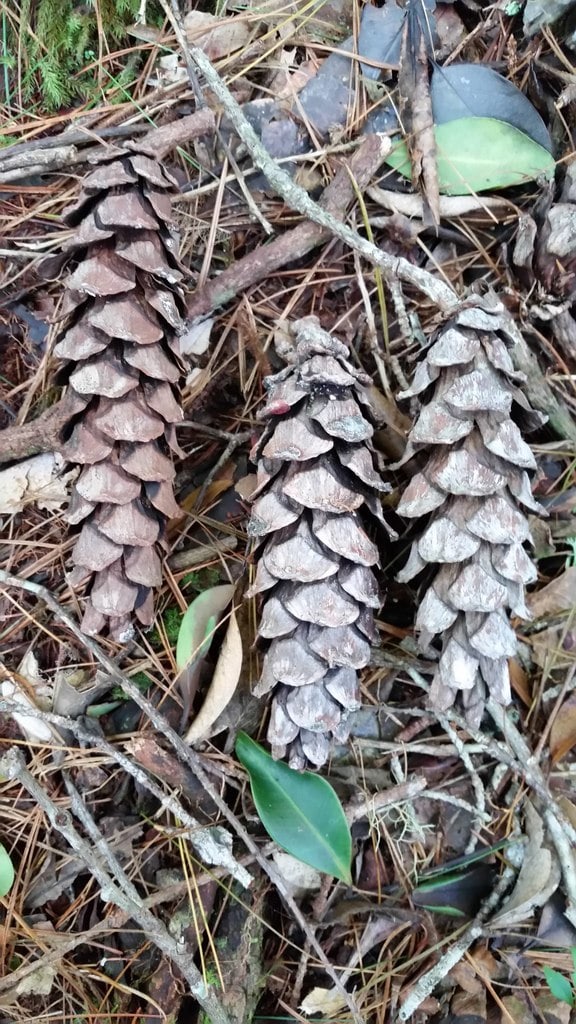
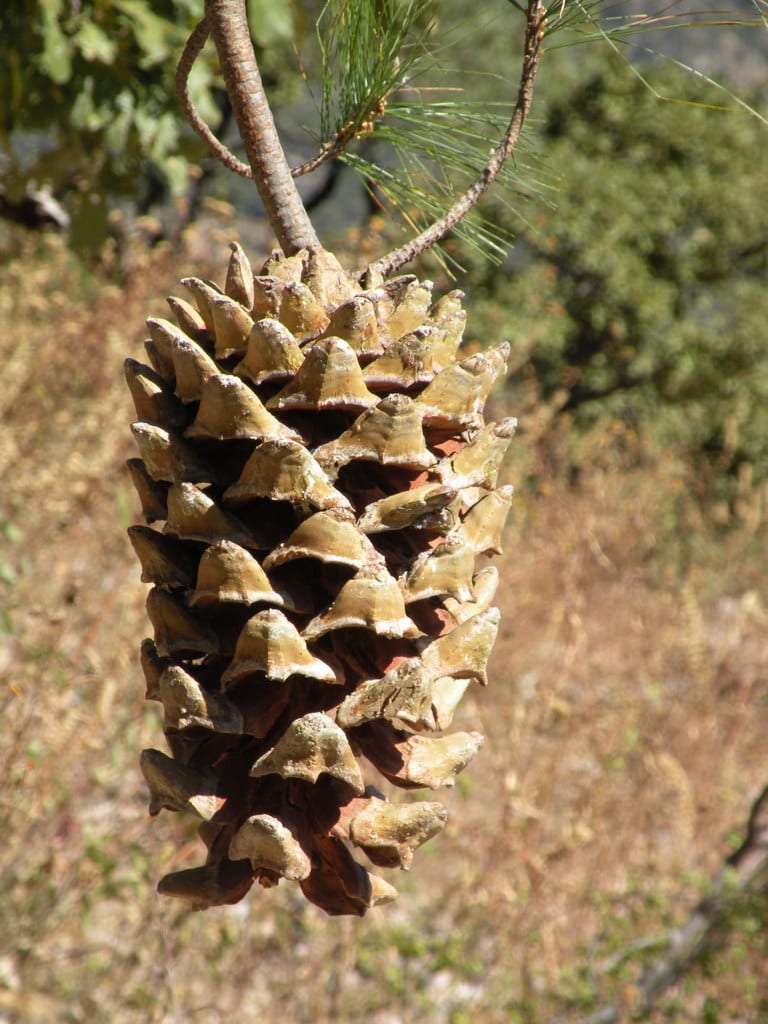
The Dalat White Pine is arguably the world’s rarest, along with its contender, the Maxipiñon of Mexico.
Dalat White Pine trees come from Vietnam, where they’re known as “Thon Nam Da”. The female cones are light brown, 4.2-6.4 inches (10.5-16 cm) long, and tapering near the tip. The seed scales are thin, bendy, and paddle-shaped.
The Maxipiñon pine is so rare that all the Maxipiñon trees known live in a small area of just 3-6 square miles (5-10 km²). They’ve only been known to science for around a decade. They were discovered when a scientist found their very large seeds in a local market!
You may also like: Types of Plants From the Dinosaur Age to the Present
Cones That Aren’t a Pine Cone
Australian Banksia
This amazing plant is not a pine, but it produces a huge flower head which then turns into a cone. It’s used as a fire starter in Australia. It also needs to be burned or completely dried out to release the seeds.
Atlas Cedar
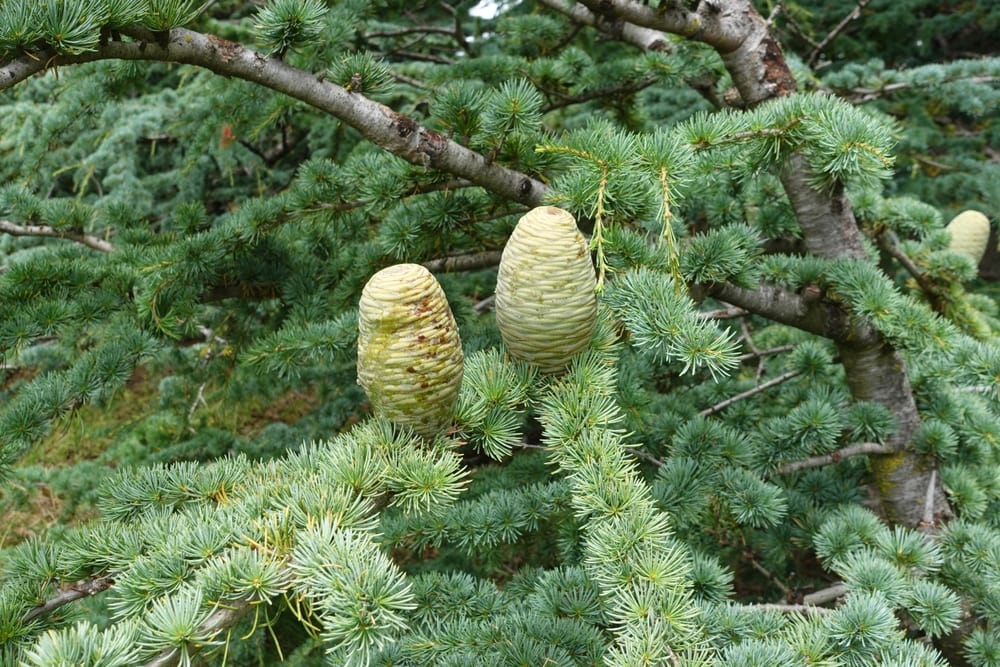
Atlas cedars aren’t a pine but a conifer. The Atlas cedar produces large, turquoise cones with smooth scales that run across in fine bands. The cone is heavy, beautiful, and smells absolutely amazing!
I took some home when I found them and warmed them on my stovetop to release their fragrant oils.
You may also like: The 35 Different Types of Evergreen Trees: Images + Facts
How Can I Identify a Pine Tree?
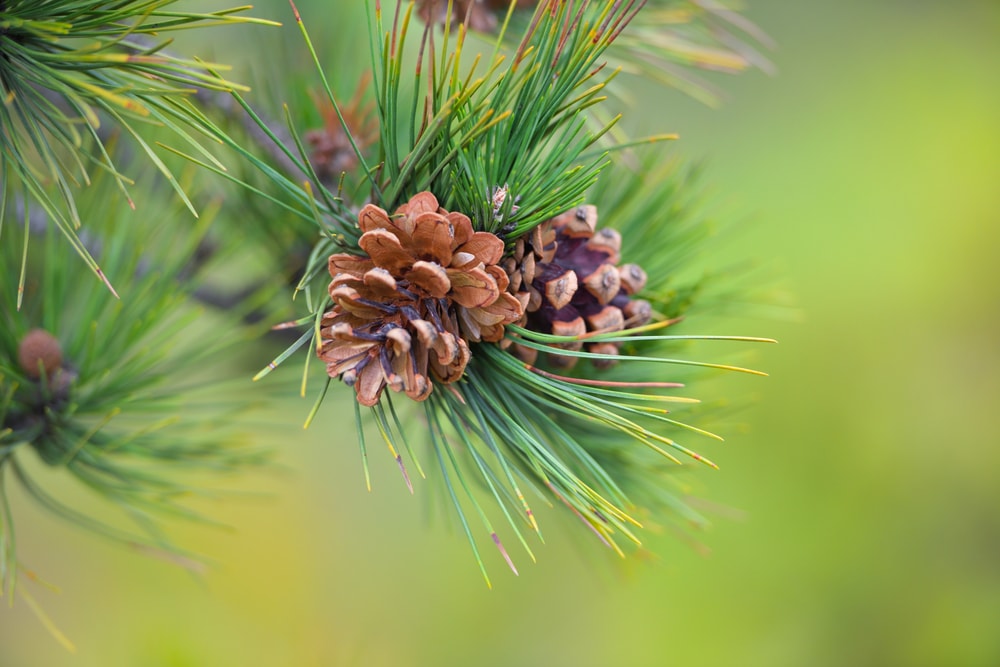
There are several parts of a pine tree to help you identify it. Here are some of the basics of a pine tree’s botanical features.
- Needle length: The thin leaves of a pine tree are called needles. You can measure them carefully and match them up to a helpful tree guide. Most botanical field guides will have the length of the needles for each species of pine.
- Needle structure: Are the needles flat or rounded? Shiny or dull? Twisted in a spiral?
- Fascicle sheath: This is the papery sleeve that holds each bunch of pine needles. Some species of pine have fascicles with only one needle in. Some have two, three, four or even five needles per sheath.
- Growth habit: Does the tree grow straight or crooked? Does the crown spread out or is it spear-shaped? How tall is it?
- Bark: Is it red, purple, white or brown? Is it peeling off? Is there a pattern in the bark?
- Cone size and shape: Measure the cones. How heavy are they? What color? Are the scales protruding or flat? Do the scales have any special features on them?
You may also like: 39 Types Of Palm Trees: The Tall, The Small, And The Weird
How Can I Tell Which Pine Cones Are the Oldest on a Tree?
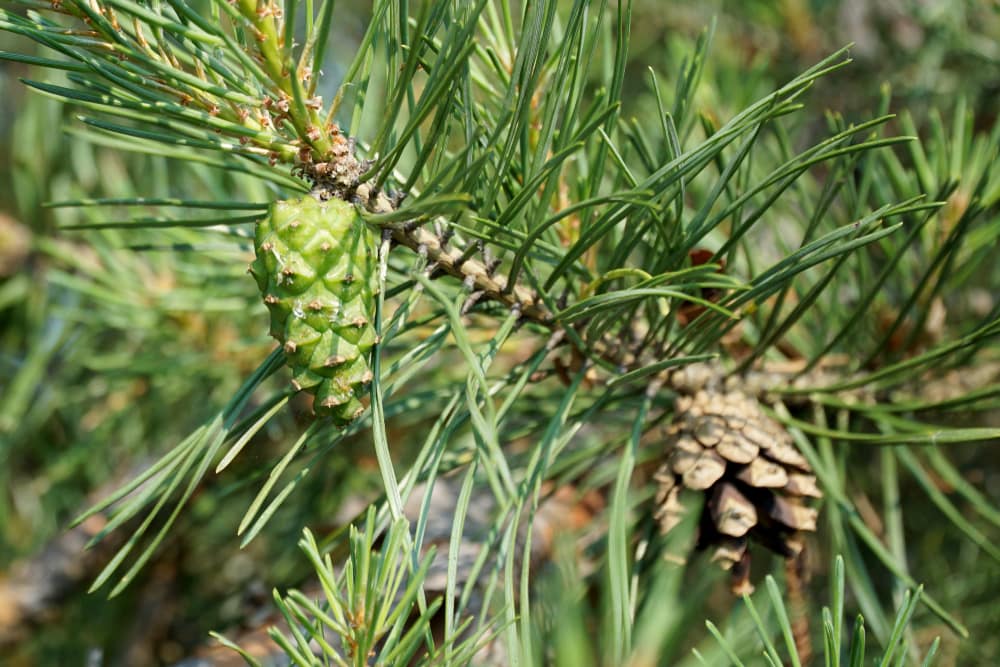
The oldest pine cones on a tree will be further back toward the trunk. The youngest cones will be right at the tips of the branches. This is because as the tree branch grows outwards, it produces pine cones.
You can also tell which are the oldest by how further along they are in development. Older cones will be brown, larger, and may have already opened to release seed. These are usually second-year pine cones.
First-year pine cones will be tightly shut, sometimes sealed with resin. They’re likely to be green in color.
The smallest and most immature pine cones will be found at the tip of the branch. Take a look next time you see a pine tree!
You may also like: National Parks Known For Big Trees: Guide To Identification and Location
Animals That Like to Eat Pine Seeds
There are lots of animals that like to eat the seeds from pine cones apart from humans!
Crossbills
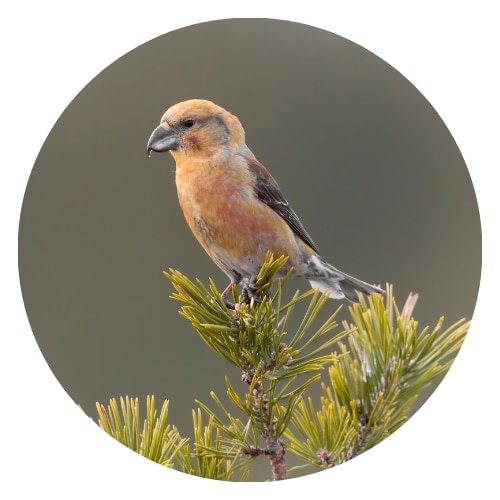
These tough little finches have a very strong beak. Their beaks are specially shaped to extract conifer and pine seeds from cones.
Take a look at their beak – it’s crossed over at the end! This gives them an ability to twist and lever out the seeds.
Woodpeckers
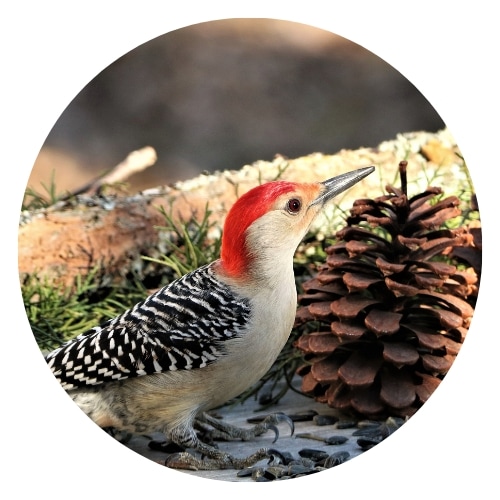
Woodpeckers love pine seeds. They wedge the cone in the crook of a tree to help them get the seeds out.
You can tell a bird such as a woodpecker has been feeding on a cone by the scales’ edges. Birds tend to rip out the seeds, leaving ragged edges.
Red & Gray Squirrels
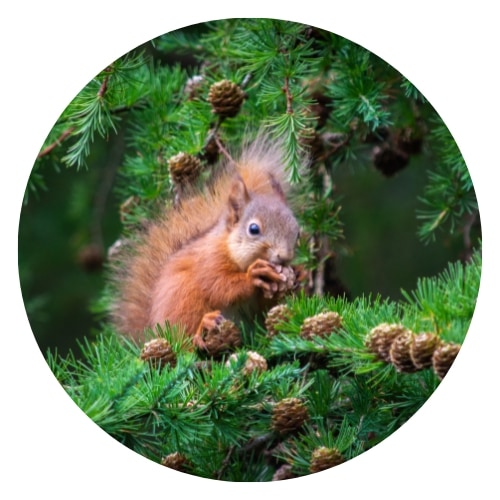
Squirrels love any type of nut, especially ones rich in fat like pine seeds. They bite off the cone scales neatly, leaving a straight line. This is how you can tell a squirrel has been feeding off a pine cone. Their teeth are very strong.
Deer
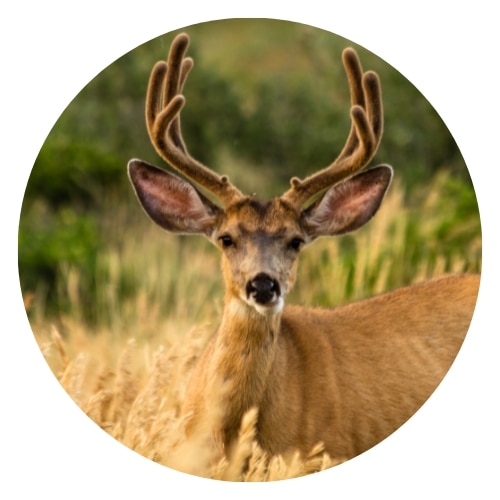
Deer do eat pine cones and needles, but only if they’re quite hungry and their favorite foods are not available. They prefer White Pine, Austrian Pine and Red Pine, only moving on to other pines if they are forced to.
Mushrooms
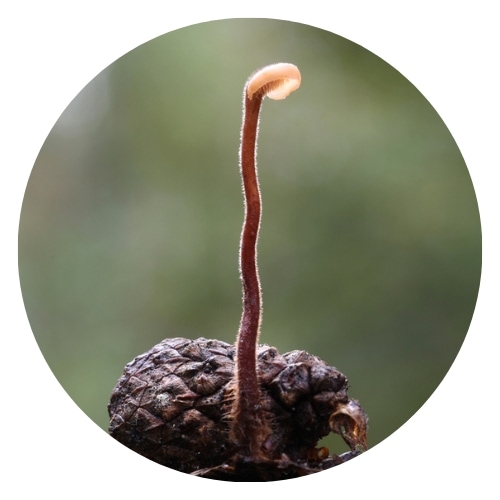
Quite a few different fungi grow on decaying pine cones.
One of these is the small, hairy, dark Auriscalpium vulgare. Otherwise known as the Earpick Fungus or Pinecone Tooth fungus. It is saprophytic, feeding off the rotting cone.
Douglas Fir-Cone Mushroom (Strobilurus trullisatus) feeds on fir cones. It’s a pretty and delicate white parasol on a long white stem.
Purple-Edged Bonnet Mushroom (Mycena purpureofusca) also feeds on pine cones. This tiny, technically poisonous mushroom contains enzymes that can help detoxify industrial dyes!
FAQs
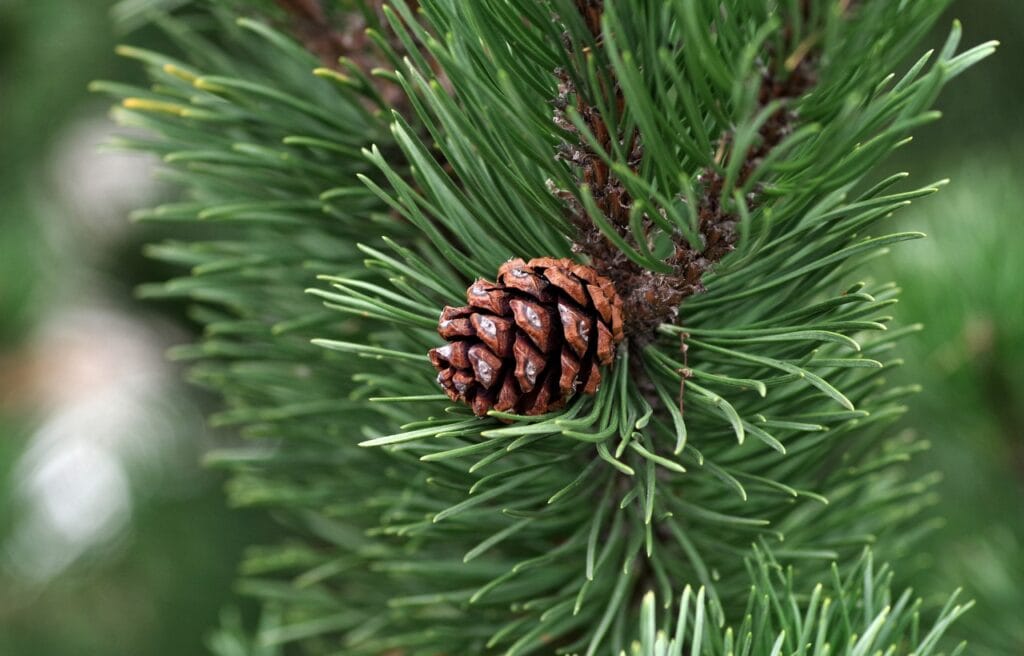
Where can I find pine trees?
Pine trees are widespread across temperate and cold regions of the world. They are found in North America and Canada, the Arctic Circle, Scandinavia, Norway, Russia, Japan and Europe. To name a few!
Are pine seeds edible?
Pine seeds are not only edible for humans, they are also very tasty and nutritious. They have been used in many recipes worldwide.
Are there other types of trees with cones?
Conifers have cones. They are different from a pine cone however.
Can you eat pine cones?
You can eat the seeds within the pine cone once they are ripe. You can’t eat the actual pine cone! This is made to protect the nutritious seeds. It’s woody and very tough!
What’s the difference between male and female pine cones?
Male pine cones are much smaller. They are usually green, orange or yellow. They feel soft to the touch as all they need to do is release pollen.
They don’t need to protect the seed. Female pine cones are much bigger, tougher and turn brown when mature.



